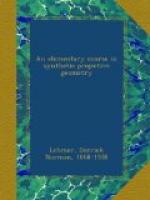163. Desargues. In 1639 Desargues,(5) an architect of Lyons, published a little treatise on the conic sections, in which appears the theorem upon which we have founded the theory of four harmonic points (§ 25). Desargues, however, does not make use of it for that purpose. Four harmonic points are for him a special case of six points in involution when two of the three pairs coincide giving double points. His development of the theory of involution is also different from the purely geometric one which we have adopted, and is based on the theorem (§ 142) that the product of the distances of two conjugate points from the center is constant. He also proves the projective character of an involution of points by showing that when six lines pass through a point and through six points in involution, then any transversal must meet them in six points which are also in involution.
164. Poles and polars. In this little treatise is also contained the theory of poles and polars. The polar line is called a traversal.(6) The harmonic properties of poles and polars are given, but Desargues seems not to have arrived at the metrical properties which result when the infinite elements of the plane are introduced. Thus he says, “When the traversal is at an infinite distance, all is unimaginable.”
165. Desargues’s theorem concerning conics through four points. We find in this little book the beautiful theorem concerning a quadrilateral inscribed in a conic section, which is given by his name in § 138. The theorem is not given in terms of a system of conics through four points, for Desargues had no conception of any such system. He states the theorem, in effect, as follows: Given a simple quadrilateral inscribed in a conic section, every transversal meets the conic and the four sides of the quadrilateral in six points which are in involution.
166. Extension of the theory of poles and polars to space. As an illustration of his remarkable powers of generalization, we may note that Desargues extended the notion of poles and polars to space of three dimensions for the sphere and for certain other surfaces of the second degree. This is a matter which has not been touched on in this book, but the notion is not difficult to grasp. If we draw through any point P in space a line to cut a sphere in two points, A and S, and then construct the fourth harmonic of P with respect to A and B, the locus of this fourth harmonic, for various lines through P, is a plane called the polar plane of P with respect to the sphere. With this definition and theorem one can easily find dual relations between points and planes in space analogous to those between points and lines in a plane. Desargues closes his discussion of this matter with the remark, “Similar properties may be found for those other solids which are related to the sphere in the same way that the conic section




